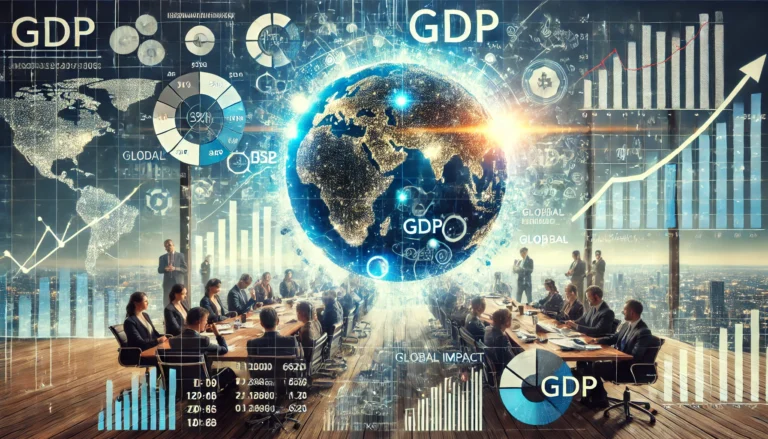Introduction
Introduce “GDP Behind the Scenes” as a gateway to understanding how economies truly function. Mention that while most people hear about GDP in news reports, the behind-the-scenes story of how it’s calculated reveals much more. Emphasize that GDP, or Gross Domestic Product, isn’t just a static figure—it’s the result of a detailed and dynamic process that shapes policies, influences investment decisions, and even impacts the daily lives of citizens.
1. GDP Behind the Scenes: What the Numbers Really Mean
GDP is a metric that quantifies the total economic output of a nation, but the actual process of deriving this number is complex. Here, explain GDP in simple terms as the total market value of all goods and services produced within a country over a specific period.
Why It Matters: For economists, policymakers, and investors, understanding GDP behind the scenes offers valuable insights into a country’s economic activity, influencing everything from tax policies to international trade agreements.
2. Unpacking GDP Components: The Core Elements That Drive the Metric
“GDP Behind the Scenes” becomes clearer when we break it down into four key components, each representing a vital part of the economy:
- Consumer Spending (C): Explain how household spending on goods and services fuels the economy. Every time we buy groceries, dine out, or purchase new clothing, we’re contributing to this component.
- Business Investment (I): Businesses contribute by investing in machinery, infrastructure, and innovation, which further drives production capacity and GDP growth.
- Government Spending (G): Government expenditures on public services, defense, infrastructure, and welfare contribute directly to GDP, impacting a nation’s growth and development.
- Net Exports (NX): Summarize how the balance of exports and imports affects GDP, showing how trade dynamics impact a country’s overall economic standing.
Example: Mention that consumer spending often makes up a significant portion of GDP in developed economies like the United States, while in export-heavy economies like China, net exports play a critical role.
3. How GDP is Calculated: The Methodology Behind the Metric
The calculation of GDP is an extensive process involving three main approaches—each of which offers a unique angle on the economy:
- The Production (or Output) Approach: This method calculates GDP by adding the output of each sector within the economy, capturing the value added by industries like agriculture, manufacturing, and services.
- The Income Approach: This method looks at GDP from an income perspective, aggregating wages, interest, rent, and profit generated within the country. Explain how this approach emphasizes the distribution of earnings and wealth across different sectors.
- The Expenditure Approach: Commonly used in economic reports, this approach sums all spending on final goods and services in an economy, capturing total demand.
Behind the Scenes: Data for these methods is sourced from various reports, business surveys, and government records. It involves extensive cross-checking and adjustments to account for inflation and seasonal variations, highlighting the meticulous process required to present GDP as an accurate measure.
4. GDP and Other Key Economic Indicators: How They Work Together
- Unemployment Rates: A growing GDP often signals increasing employment, as companies expand and hire more workers. Conversely, a shrinking GDP can indicate rising unemployment.
- Inflation: Explain how GDP growth can lead to inflationary pressures and how central banks may intervene to control excessive growth.
- Trade Balances: Discuss how GDP interacts with trade balance data to reflect a nation’s competitiveness on a global scale.
Comparison: Highlight how GNP (Gross National Product) differs by including earnings from overseas investments. Although GNP is a useful measure, “GDP Behind the Scenes” focuses solely on domestic productivity.
5. Limitations of GDP: The Untold Story Behind the Scenes
While GDP is essential, it has limitations. It doesn’t measure income inequality, environmental sustainability, or the value of unpaid labor, such as caregiving. Some economists argue that GDP alone cannot reflect the well-being of a nation’s citizens.
- Environmental Costs: A country may have a high GDP due to resource extraction industries, but this growth could come at the cost of environmental degradation.
- Informal Economy: In many developing countries, informal sectors contribute significantly to economic activity but are often underrepresented in GDP.
- Alternative Measures: Introduce measures like the Human Development Index (HDI) or Green GDP, which aim to capture broader dimensions of well-being.
Insight: The limitations underscore the importance of looking at “GDP Behind the Scenes” with a critical eye and using complementary indicators for a more comprehensive view.
6. Global Comparisons: GDP Across Major Economies
Present a comparison of GDP figures from various countries, highlighting the differences in their economic structures and key growth drivers.
| Country | GDP (USD Trillion) | Growth Rate (%) | Key Economic Drivers |
|---|---|---|---|
| United States | 22.7 | 2.0 | Services, Technology |
| China | 16.6 | 8.1 | Manufacturing, Exports |
| Japan | 4.9 | 1.8 | Technology, Manufacturing |
Analysis: While the United States relies heavily on its service sector, China’s economy is export-driven, with a significant emphasis on manufacturing. This “behind-the-scenes” structure explains why each nation’s GDP growth can be influenced by different global events and policies.
7. Policy and Business Impacts: The Practical Side of GDP
Behind GDP are decisions that affect policies and business strategies. Governments monitor GDP trends to decide on:
- Monetary Policy: Central banks may adjust interest rates based on GDP growth or decline, influencing borrowing and spending.
- Fiscal Policy: Governments may increase spending during GDP declines to stimulate growth or cut spending to cool off an overheating economy.
- Tax Policies: GDP growth often leads to tax policy shifts, impacting corporate investments and personal income.
Business Impact: Companies monitor GDP data to make informed decisions about expansion, hiring, and investment. Explain how multinational companies use GDP trends to determine which markets to enter, reflecting a practical use of “GDP Behind the Scenes.”
Conclusion
Summarize the journey through “GDP Behind the Scenes,” underscoring how this metric is much more than a number on a report. Understanding GDP’s complexities helps us grasp how policies are shaped, how businesses strategize, and how resources are allocated to foster growth. Emphasize that while GDP is essential, looking beyond its headline value allows for a deeper appreciation of what drives economic prosperity.

